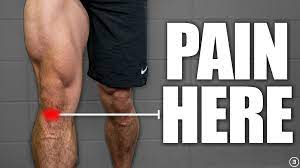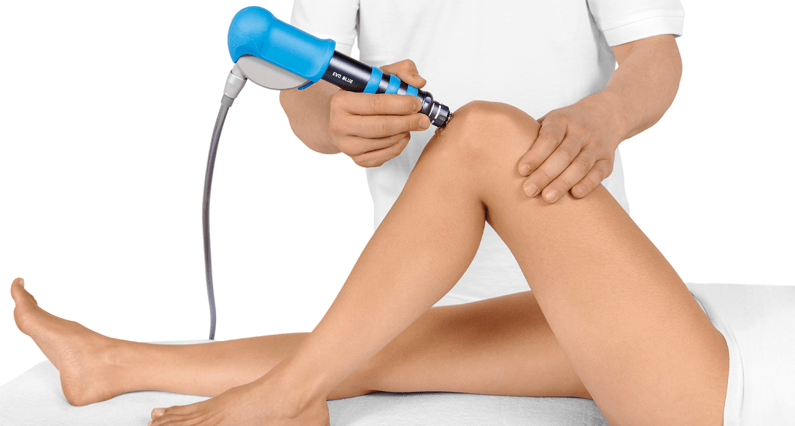At Physio Tullamore we see athletes and patients that suffer with Patella Tendinopathy / Jumpers knee. We will explain what the condition
is and your management options.
Introduction
Tendinopathy of the knee is a common musculoskeletal condition characterized by pain, swelling, and dysfunction of the knee tendons. It affects individuals of all ages and activity levels, from sedentary individuals to elite athletes. This essay explores the multifaceted approach to managing knee tendinopathy, including its causes, diagnosis, conservative treatments, and surgical interventions.
I. Understanding Knee Tendinopathy
1.1. Anatomy of the Knee Tendons

To effectively manage knee tendinopathy, it is crucial to understand the relevant anatomy. The primary tendons affected in knee tendinopathy
are the patellar tendon (patellar tendinopathy) and the quadriceps tendon. These tendons play a vital role in knee extension and are subject
to repetitive stress during activities involving jumping, running, and kicking.
1.2. Causes and Risk Factors
Several factors contribute to the development of knee tendinopathy:
1.2.1. Overuse and Repetitive Stress: Excessive or repetitive loading of the knee tendons, such as in sports like basketball or soccer, can lead to tendinopathy.
1.2.2. Poor Biomechanics: Abnormal lower limb biomechanics, including muscle imbalances or joint malalignment, can increase the risk of tendinopathy.
1.2.3. Age and Degeneration: Tendinopathy is more common in individuals over the age of 30 due to the natural degeneration of tendons with age.
1.2.4. Training Errors: Sudden increases in training intensity, inadequate rest, and improper technique can contribute to tendinopathy development.
II. Diagnosis of Knee Tendinopathy
2.1. Clinical Assessment
At Physio Tullamore we diagnose knee tendinopathy using a comprehensive clinical assessment, which includes:
2.1.1. Medical History: Gathering information about the patient's symptoms, activity level, and any previous injuries or treatments.
2.1.2. Physical Examination: A thorough examination of the knee, including palpation of the affected tendon, assessment of range of motion, strength testing, and evaluation of functional deficits.
2.1.3. Imaging: While not always necessary, imaging modalities such as ultrasound or magnetic resonance imaging (MRI) can provide valuable information about tendon integrity and potential structural abnormalities.
2.2. Differential Diagnosis
It is essential to differentiate knee tendinopathy from other conditions that may present with similar symptoms, such as meniscal tears, ligament injuries, or osteoarthritis. Accurate diagnosis guides appropriate treatment strategies.
III. Conservative Management
3.1. Rest and Activity Modification
One of the primary goals of managing knee tendinopathy is to reduce the load on the affected tendon. Rest and activity modification are often the first steps in conservative management. This may involve temporarily avoiding activities that exacerbate symptoms, modifying training routines, and allowing the tendon to heal.
3.2. Physical Therapy
Physical therapy plays a crucial role in the conservative management of knee tendinopathy. A physical therapist can design a personalized exercise program that includes:
3.2.1. Eccentric& Isometric Strengthening: Eccentric exercises, which focus on the controlled lengthening of the affected tendon, are often a cornerstone of tendinopathy rehabilitation.
3.2.2. Stretching and Flexibility: Improving the flexibility of the quadriceps and hamstring muscles can alleviate tension on the tendon.
3.2.3. Biomechanical Correction: Addressing abnormal biomechanics through gait analysis and corrective exercises can reduce stress on the tendon.
3.3. Modalities and Interventions

At Physio Tullaore we offer extracorporeal shockwave therapy (ESWT) to assist in pain management and tendon healing.
3.4. Anti-Inflammatory Medications
Non-steroidal anti-inflammatory drugs (NSAIDs) may be prescribed to manage pain and inflammation, but their long-term use should be monitored carefully due to potential side effects.
IV. Advanced Treatments
4.1. Platelet-Rich Plasma (PRP) Therapy
PRP therapy involves injecting a concentrated solution of the patient's own platelets into the affected tendon to promote healing. PRP has shown promise in accelerating recovery in some cases of knee tendinopathy.
4.2. Corticosteroid Injections
Corticosteroid injections may be considered for short-term pain relief but should be used judiciously due to the potential risk of tendon weakening with repeated use.
4.3. Tenex Procedure
The Tenex procedure, or percutaneous tenotomy, is a minimally invasive technique that utilizes ultrasound guidance to remove damaged tissue within the tendon. It can be a viable option for patients who have not responded to conservative treatments.
V. Surgical Intervention
5.1. Arthroscopic Debridement
When conservative treatments fail, arthroscopic debridement may be necessary. This procedure involves the removal of damaged tissue and smoothing of the tendon surface through small incisions, often with the aid of an arthroscope.
5.2. Tendon Transfer
In severe cases of knee tendinopathy where the tendon is significantly damaged, a tendon transfer may be considered. This involves surgically transferring a healthy tendon from another part of the body to replace the damaged knee tendon.
5.3. Rehabilitation Following Surgery
Rehabilitation following surgical intervention is a crucial component of a successful outcome. Physical therapy is essential to regain strength, range of motion, and function while allowing the surgical site to heal properly.
VI. Prevention and Long-Term Management
Preventing knee tendinopathy involves proper training techniques, gradual progression of activity, and attention to biomechanical factors. Athletes and individuals with a history of tendinopathy should adopt ongoing strategies for managing load, maintaining strength, and addressing any recurring symptoms to prevent relapse.
Conclusion
The management of knee tendinopathy is a multifaceted process that combines accurate diagnosis, conservative treatments, advanced
interventions, and, when necessary, surgical options. A comprehensive approach that considers the patient's individual needs, activity
level, and response to treatment is essential for achieving successful outcomes and returning patients to pain-free knee function. As
ongoing research continues to refine our understanding of tendinopathy, the management strategies outlined in this essay are expected to
evolve, offering even better solutions for those affected by this common and challenging condition.
For more information on patella tendinopathy drop us an email or book online www.physiotullamore.com/book-online